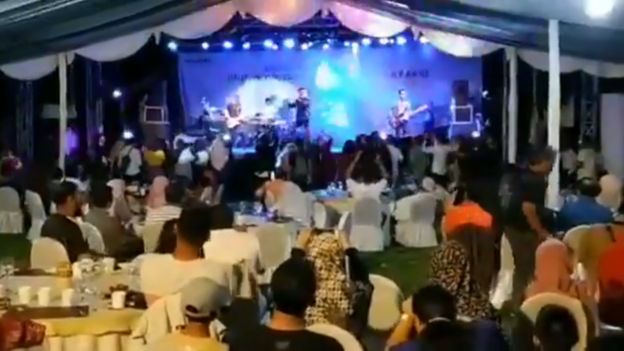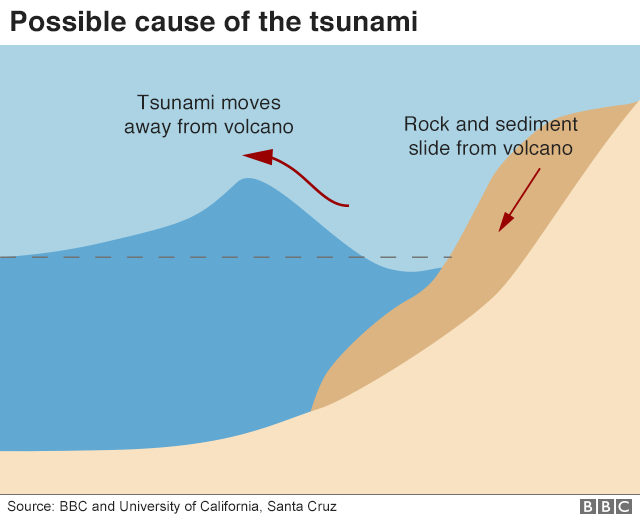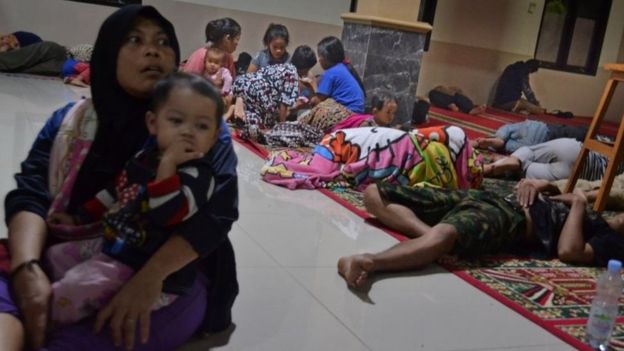(BBC) At least 222 people have been killed and 843 injured after a tsunami hit coastal towns on Indonesia’s Sunda Strait, government officials say.
There was no warning of the giant waves which struck at night, destroying hundreds of buildings, sweeping away cars and uprooting trees.
It is thought undersea landslides from the Anak Krakatau volcano caused them.
President Joko Widodo has expressed his sorrow for the victims and urged people to be patient.
Rescue efforts are being hampered by blocked roads but heavy lifting equipment is being transported to badly hit areas to help search for victims.
The Sunda Strait, between the islands of Java and Sumatra, connects the Java Sea to the Indian Ocean.
What do we know so far?
The disaster management agency has warned people to stay away from the coastline due to fears of another tsunami.
Saturday’s tsunami struck at about 21:30 local time (14:30 GMT), during a local holiday.
It hit several popular tourist destinations including the Tanjung Lesung beach resort in the west of Java island.
Footage shared on social media showed a large wave crashing into a tent in the resort, in which popular Indonesian rock band Seventeen was performing. Members of the band were seen being swept away as the wave destroyed the stage.


In a tearful Instagram video, singer Riefian Fajarsyah said the band’s bassist and road manager had died, and three other band members and his own wife were missing.
Red Cross official Kathy Mueller told the BBC: “There is debris littering the ground, crushed cars, crushed motorcycles, we’re seeing buildings that are collapsed.”
It appears that the main road into Pandeglang has been badly damaged, making it difficult for rescuers to reach the area, she added.
Eyewitness Asep Perangkat said cars and containers had been dragged about 10 metres (32 feet).


“Buildings on the edge of [Carita] beach were destroyed, trees and electricity poles fell to the ground,” he told AFP news agency.
Officials say more than 160 people were killed in Pandeglang – a popular tourist district on Java known for its beaches and national park.
Meanwhile, 48 were reported dead in South Lampung on Sumatra, and deaths were also reported in Serang district and Tanggamus on Sumatra. Officials fear the death toll could rise further.


So far, no foreign nationals have been reported dead, officials say.



What caused the tsunami?
By Jonathan Amos, BBC science correspondent
It is well known that volcanoes have the capacity to generate large waves. The mechanism as ever is the displacement of a large volume of water.
Except, unlike in a classic earthquake-driven tsunami in which the seafloor will thrust up or down, it seems an eruption event set in motion some kind of slide.


It is not clear at this stage whether part of the flank of the volcano has collapsed with material entering the sea and pushing water ahead of it, or if movement on the flank has triggered a rapid slump in sediment under the water surface.
The latter at this stage appears to be the emerging consensus, but the effect is the same – the water column is disturbed and waves propagate outwards.



Were there danger signs before the tsunami?
Anak Krakatau has seen increased activity in recent months. Indonesia’s geological agency says the volcano erupted for two minutes and 12 seconds on Friday, creating an ash cloud that rose 400 metres above the mountain.
It recommended that no-one be allowed within 2km (1.2 miles) of the crater.


After the tsunami struck, there was confusion over what had actually happened, with Indonesian disaster agency spokesman Sutopo Purwo Nugroho initially reporting it as a tidal surge.
He later apologised for his mistake, saying there had been confusion because there was no earthquake.
High seas as a result of the full moon might have contributed to the strength of the waves, the disaster management agency said.
The proximity of the volcano to the coast gave authorities very little time to act, Professor David Rothery from The Open University told AFP news agency.
“Tsunami warning buoys are positioned to warn of tsunamis originated by earthquakes at underwater tectonic plate boundaries,” he said.
“Even if there had been such a buoy right next to Anak Krakatau, this is so close to the affected shorelines that warning time would have been minimal given the high speeds at which tsunami waves travel.”
Adding to the anxiety on Sunday, a tsunami warning went off by mistake, causing widespread panic as people scrambled to reach shelters. A technical error is suspected.
How common are tsunamis in Indonesia?


Indonesia is prone to tsunamis because it lies on the Ring of Fire – the line of frequent earthquakes and volcanic eruptions that circles virtually the entire Pacific rim.
In September, more than 2,000 people died when a powerful earthquake struck just off the central Indonesian island of Sulawesi, setting off a tsunami that engulfed the coastal city of Palu.
On 26 December 2004, a series of huge waves triggered by a powerful earthquake in the Indian Ocean killed about 228,000 people in 13 countries, mostly in Indonesia.
However, tsunamis caused by volcanic activity like this are less frequent.
Krakatoa (Krakatau in Indonesian)


Anak Krakatau (Child of Krakatau) is a new island that emerged in 1927 from Krakatoa volcano.
In August 1883, Krakatoa underwent one of the most violent volcanic eruptions in recorded history:
- Massive tsunamis with waves of up to 41m killed more than 30,000 people
- Thousands more were killed by hot ash
- The eruptions were equivalent to 200 megatons of TNT – about 13,000 times the nuclear yield of the bomb dropped on Hiroshima in 1945
- The eruptions were heard thousands of kilometres away
- World temperatures dropped by more than 1C the following year
- The volcanic island virtually disappeared
